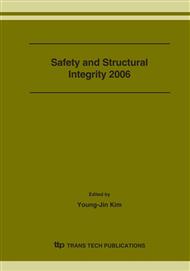[1]
Shibata, H., 1974, Survey report on earthquake damage of industrial facilities in the world- Spherical vessels and cylindrical vessels- , (in Japanese), Annual report Ins. of Ind. Science University of Tokyo, Vol. 26, No. 7, pp.13-18.
Google Scholar
[2]
Shibata, H. et al., 1983, On some results on response observation of liquid storage tanks to natural earthquakes, Proc. of ASME PVP Conf., Vol. 77, pp.21-28.
Google Scholar
[3]
Combescure,A. et al., 1981, On fluid structure interaction and buckling of thin shells under seismic load, Proc. of 6 th SMiRT, B5/6, pp.1-7.
Google Scholar
[4]
Liu, W.K. and Uras R.A., 1989, Transient buckling analysis of liquid -storage tanks : Part 1, Proc. of ASME PVP Conf., Vol. 157, pp.35-40.
Google Scholar
[5]
Ito, T. et al., 1992, Study on dynamic buckling simulation methodology for cylindrical shell due to seismic excitation(1 st report, evaluation of influence of initial imperfection), (in Japanese), Trans. of JSME, Vol. 58, No. 552, pp.87-92.
Google Scholar
[6]
Chiba, M. et al., 1988, Dynamic stability of liquid -filled cylindrical shells under periodic shearing forces, Proc. of ASME PVP Conf., Vol. 4, pp.241-253.
Google Scholar
[7]
Natsiavas, S. and Babcock C.D., 1987, Buckling of the top of a fluid filled tank during base excitation, Proc. of ASME PVP Conf., Vol. 127, pp.333-338.
DOI: 10.1115/1.3264919
Google Scholar
[8]
Hara, F. and Suzuki,R., 1999, Simulation analysis of fluid-coupled parametric vibration in a cylindrical shell, (in Japanese), Proc. of JSME Conf., No. 99-1, pp.445-446.
Google Scholar
[9]
Shih, C.F. and Babcock C.D., 1980, Scale model buckling tests of fluid filled tank under harmonic excitation, Proc. of Century 2 ASME PVP Conf., 80-C2, Vol. 66, pp.1-7.
Google Scholar
[10]
Matsuura,S. et al., 1995, Studies on the seismic buckling design guideline of FBR main vessels(5 th report, applicability of the numerical buckling analysis method), (in Japanese), Trans. of JSME, Vol. 61, No. 585, pp.138-146.
Google Scholar
[11]
The Japan Electric Association, 1984, Technical Guideline for Aseismic Design of Nuclear Power Plant- , (in Japanese), The Japan Electric Association.
Google Scholar
[12]
AIJ, 1996, Design Recommendation for Storage Tanks and Their Supports (Vr. 3), (in Japanese), AIJ.
Google Scholar


